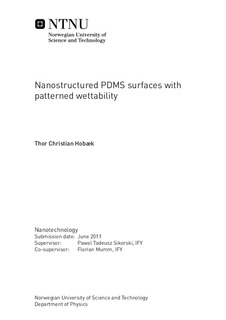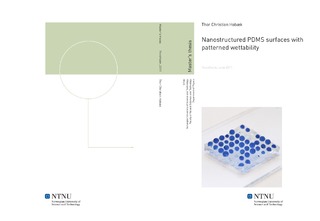| dc.description.abstract | In this study, a surface with patterned wettability by means of surface structuring, rather than through modifying the surface chemistry, was developed. The device presented in this thesis was inspired by the Namib Desert Bettle, which collects water from the fog by having hydrophilic spots surrounded by hydrophobic wax-coated regions on its back. Besides water collection, controlling the wetting behaviour locally on the surface may find applications within droplet-based microfluidics, or fabrication of DNA, protein or cell microarrays. Spatial wetting contrast was achieved through replica moulding of the elastomer polydimethylsiloxane (PDMS), using a copper and/or the epoxy-based SU-8 photoresist surface as a template. Different types of surface roughness was produced and characterized on polycrystalline copper, through etching, oxidation, electrodeposition, or a combination. Regions with no surface roughness was patterned on the template moulds through conventional UV-photolithography processing of SU-8. The PDMS replicas were then tested for the ability to capture water droplets selectively on the patterned spots. Through characterization of the surface roughness by atomic force microscopy (AFM) and scanning electron microscopy (SEM), copper plates etched with a solution of CuCl2 and HCl produced the highest amount of surface roughness, with longer etching times leading to increased surface roughness. To characterize the hydrophobicity, the contact angle was measured for droplets deposited on the rough PDMS surfaces. Through surface structuring, the contact angle was increased from 101.8 ± 3.6◦ for a flat surface, to 154.7 ± 5.3◦ for the PDMS surface with the highest roughness. The polarity of surface roughness was also found to play an important role in the wetting behaviour, with a higher number of peaks than valleys being preferable. The fabricated PDMS surfaces showed spatial wetting contrast, as demonstrated in the cover photo. The device needs further optimization in terms of increasing the hydrophobicity of the rough regions, as well as changing the pattern geometries. However, the discoveries made in this study may be useful for further development and integration with droplet-moving mechanisms, for future lab-on-a-chip applications within medical diagnostics or chemical analysis. | nb_NO |

